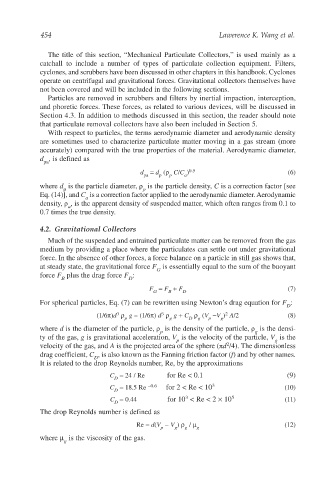Page 482 - Air Pollution Control Engineering
P. 482
12_ch_wang.qxd 05/05/2004 5:26 pm Page 454
454 Lawerence K. Wang et al.
The title of this section, “Mechanical Particulate Collectors,” is used mainly as a
catchall to include a number of types of particulate collection equipment. Filters,
cyclones, and scrubbers have been discussed in other chapters in this handbook. Cyclones
operate on centrifugal and gravitational forces. Gravitational collectors themselves have
not been covered and will be included in the following sections.
Particles are removed in scrubbers and filters by inertial impaction, interception,
and phoretic forces. These forces, as related to various devices, will be discussed in
Section 4.3. In addition to methods discussed in this section, the reader should note
that particulate removal collectors have also been included in Section 5.
With respect to particles, the terms aerodynamic diameter and aerodynamic density
are sometimes used to characterize particulate matter moving in a gas stream (more
accurately) compared with the true properties of the material. Aerodynamic diameter,
d , is defined as
pa
d = d (ρ C/C ) 0.5 (6)
pa p p a
where d is the particle diameter, ρ is the particle density, C is a correction factor [see
p p
Eq. (14)], and C is a correction factor applied to the aerodynamic diameter. Aerodynamic
a
density, ρ , is the apparent density of suspended matter, which often ranges from 0.1 to
a
0.7 times the true density.
4.2. Gravitational Collectors
Much of the suspended and entrained particulate matter can be removed from the gas
medium by providing a place where the particulates can settle out under gravitational
force. In the absence of other forces, a force balance on a particle in still gas shows that,
at steady state, the gravitational force F is essentially equal to the sum of the buoyant
G
force F plus the drag force F :
B D
F = F + F (7)
G B D
For spherical particles, Eq. (7) can be rewritten using Newton’s drag equation for F :
D
3
2
3
(1/6π)d ρ g = (1/6π) d ρ g + C ρ (V −V ) A/2 (8)
p g D g p g
where d is the diameter of the particle, ρ is the density of the particle, ρ is the densi-
p g
ty of the gas, g is gravitational acceleration, V is the velocity of the particle, V is the
p g
2
velocity of the gas, and A is the projected area of the sphere (πd /4). The dimensionless
drag coefficient, C , is also known as the Fanning friction factor (f) and by other names.
D
It is related to the drop Reynolds number, Re, by the approximations
C = 24 / Re for Re < 0.1 (9)
D
C = 18.5 Re −0.6 for 2 < Re < 10 3 (10)
D
3
C = 0.44 for 10 < Re < 2 × 10 5 (11)
D
The drop Reynolds number is defined as
Re = d(V − V ) ρ / µ (12)
p g g g
where µ is the viscosity of the gas.
g

